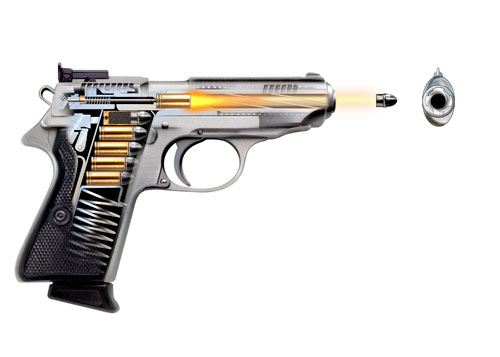Weapons Ballistics |
||
Forensic Ballistics 
 Site By: Darren Klein |
When a forensic investigation involves a shooting, ballistics becomes an important facet of the investigation. Ballistics is a term that means the science of the flight path of a bullet. The flight path includes the movement of the bullet down the barrel of the firearm following detonation and its path through both the air and the target. Tracing the path of a bullet is important in a forensic examination. It can show from what direction the bullet was fired, which can be important in corroborating the course of events in the crime or accident. It is an obvious truism that the distance that a bullet can travel depends on its speed. A higher speed imparts more energy to the bullet. The frictional resistance of the air and the downward pull of gravity will take longer to slow the bullet's flight, as compared to a bullet moving at a lower initial velocity. Generally, a bullet fired from a rifle will carry more energy than a bullet fired from a handgun. This is because the stronger firing chamber of a rifle is able to withstand the increased explosive power of a larger quantity of powder that would likely rupture the barrel of the handgun. Detonation of the powder in a rifle or handgun supplies the thrust to propel the bullet down the barrel. Expansion of the exploding gunpowder generates pressure, which is measured as the force of the explosion that pushes on the area of the bullet's base. This area is essentially the diameter of the barrel of the firearm, which remains constant. Thus, the explosive energy that passes to the bullet depends on the mass of the bullet multiplied by the force of the explosion multiplied by the time that the force is applied (i.e., the time the bullet is in the barrel). A longer barrel will produce a faster moving bullet. Once a bullet leaves the rifle or gun barrel, the aforementioned frictional and gravitational forces begin to slow its speed, producing a downward arc of flight. The frictional force is affected by the bullet's shape. A blunt shape will present more surface area to the air than will a very pointed bullet. Another factor that affects the flight of a bullet is called yaw. As in an orbiting spacecraft or a football tossed through the air, yaw causes a bullet to turn sideways or tumble in flight. This behavior is decreased when the object spins as it moves forward (the spiraling motion of a football). The barrel of a rifle or gun contains grooves that cause the bullet to spin. More damage results from a bullet that is tumbling rather than moving in a tight spiral. The shape of a typical bullet—much like a football with one end blunt instead of tapered—is a compromise that reduces air resistance while still retaining the explosive energy that allows the bullet to damage the target. The composition of a bullet is also important. Lead is commonly used to form the core of bullets. However, because it tends to deform, the blending in of other metals (typically antimony and copper) produces a bullet that can withstand the pressure of flight and impart high energy to the target upon impact. Copper is often used to jacket the inner lead core of a bullet. However, some bullets are deliberately made without this full metal jacket. Instead, the bullet has a tip made of lead or a tip that is hollow or very blunt. These bullets deform and break apart on impact, producing more damage to the target than is produced by a single piece of metal. This is because the bullet's energy is dissipated within a very short distance in the tissue. Forensic and medical examiners are able to assess the nature of tissue damage in a victim and gain an understanding of the nature of the bullet used. A bullet produces tissue damage in three ways. First, a bullet can shred (lacerate) or crush tissue or bone. Bullets moving at relatively low velocity do most of their damage this way. Fragmentation of bone can cause further damage, as the bone shards themselves become missiles. The second form of damage is known as cavitation. This damage is produced by the forward movement of air or tissue in the wake of the bullet. The wound that is produced by the bullet is destructively broadened by the force of the moving air or tissue. In a tissue, this produces even more structural damage. Third, the air at the front and sides of a very fast moving bullet can become compressed. The explosive relaxation of the compression generates a damaging shock wave that can be several hundred atmospheres in pressure. Fluid-filled organs such as the bladder, heart, and bowel can be burst by the pressure. Recovery of bullets can be a very useful part of forensic ballistics. A variety of bullet designs exist, some that are specific to the firearm. Furthermore, the scouring of a bullet's surface as it encounters the grooves of the firearm barrel can produce a distinctive pattern that enables a bullet to be matched with the firearm. A weapon recovered from a suspect can be test fired and the bullet pattern compared with a bullet recovered from the scene to either implicate or dismiss involvement of the firearm in the crime. This aspect of ballistics was crucial in convicting John Allen Muhammad and John Lee Malvo of the 10 sniper murders and the wounding of three others in the Washington, D.C. area that occurred during three weeks in October of 2002. |
|